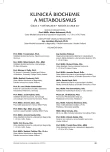Definition of sepsis and septic shock
Authors:
M. Holub
Authors‘ workplace:
Klinika infekčních nemocí 1. LF UK a ÚVN Praha
Published in:
Klin. Biochem. Metab., 26, 2018, No. 2, p. 76-78
Overview
Objective:
to describe development of sepsis and septic shock definition over the time.
Design:
literature review. Material and methods: evaluation of the sepsis understanding over the time based on published articles.
Results:
first scientific definition of sepsis was published in 1914. The definition described sepsis as bacterial infection spreading to the blood stream and giving rise to metastatic infections. This definition was significantly changed in 1989, when new nosological unit – systemic inflammatory response syndrome (SIRS) – was introduced in clinical medicine. In 1992 sepsis was defined as presence of SIRS with infection (currently, the definition is named Sepsis-1). Another slight change of sepsis definition was done in 2001, when beside other important biomarkers such C - reactive protein, procalcitonin and lactate were added (currently, the definition is named Sepsis-2). In 2016 another sepsis definition was accepted; the definition is covering a wide scale of clinical situations and is named Sepsis-3. The presence of SIRS is not now necessary for sepsis diagnosis, but the most important feature is organ failure, which is equivalent to term severe sepsis in Sepsis-1 and Sepsis-2 definitions. Evolution of the definition is reflecting improvement of knowledge of sepsis and septic shock pathophysiology, which is necessary condition for development of new diagnostic and therapeutic approaches.
Conclusion:
importance of organ failure in Sepsis-3 definition has significantly shifted sepsis to intensive care medicine. New insights are important for early detection of sepsis cases in prehospital, emergency and standard care settings.
Keywords:
Sepsis; SIRS; definition; Sepsis-3
Sources
1. Funk, D. J., Parrillo, J. E., Kumar, A. Sepsis and septic shock: a history. Crit. Care Clin., 2009, vol. 25 (1), p. 83-101.
2. Balk, R. A., Bone, R. C. The septic syndrome. Definition and clinical implications. Crit. Care Clin., 1989, vol. 5 (1), p. 1-8.
3. Bone, R. C., Balk, R. A., Cerra, F. B., et al. Definitions for sepsis and organ failure and guidelines for the use of innovative therapies in sepsis. The ACCP/SCCM Consensus Conference Committee. American College of Chest Physicians/Society of Critical Care Medicine. Chest., 1992, vol. 101(1), p. 1644-1655.
4. Levy, M. M., Fink, M. P., Marshall, J. C, et al. 2001 SCCM/ESICM/ACCP/ATS/SIS International Sepsis Definitions Conference. Crit Care Med., 2003, vol. 31(4), p. 1250-1256.
5. Singer, M., Deutschman, C. S., Seymour, C. W., et al. The Third International Consensus Definitions for Sepsis and Septic Shock (Sepsis-3). JAMA, 2016, vol. 315(8), p. 801-810.
6. Holub, M., Beran O. Nová definice sepse a septického šoku. Klin. Mikrobiol. Infekc. Lek., 2016, vol. 22(4), p. 141-143.
Labels
Clinical biochemistry Nuclear medicine Nutritive therapist Intensive Care Medicine Trauma surgeryArticle was published in
Clinical Biochemistry and Metabolism

2018 Issue 2
Most read in this issue
- Definition of sepsis and septic shock
- Glycated albumin in blood serum/plasma. Brief overview of the current state.
- Neurofilaments in traumatic brain injury – current knowledge
- Comparison of different electrophoretic systems in the laboratory diagnosis of monoclonal gammopathy
